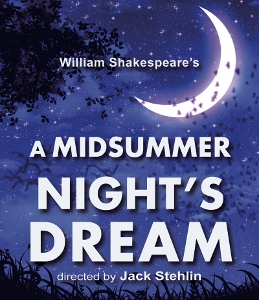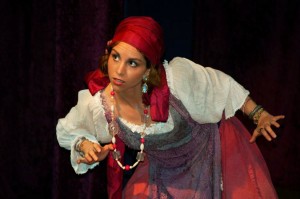BOTTOM IS TOPS
Unlike Shakespeare’s tragedies and histories, which are mostly named for their main character, his comedies have rather different kinds of titles. These differing titles alert us to the comedies’ vastly different subject matter, which is less about 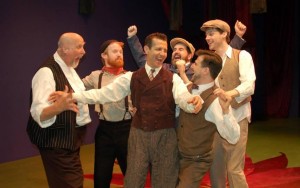 particular characters than about particular events. Who, for example, is the main character in Shakespeare’s beloved A Midsummer Night’s Dream , a charming production of which is now playing at the Odyssey Theatre? Is it Oberon, the fairy king, who works behind the scenes to cause Demetrius to fall in love with Helena, thereby allowing Hermia and Lysander to marry? Or is it Hermia, whose opposition to marrying Demetrius gets the plot of A Midsummer Night’s Dream moving? Perhaps it’s Theseus, whose marriage to Hippolyta provides the hinges on which the plot is hung?
particular characters than about particular events. Who, for example, is the main character in Shakespeare’s beloved A Midsummer Night’s Dream , a charming production of which is now playing at the Odyssey Theatre? Is it Oberon, the fairy king, who works behind the scenes to cause Demetrius to fall in love with Helena, thereby allowing Hermia and Lysander to marry? Or is it Hermia, whose opposition to marrying Demetrius gets the plot of A Midsummer Night’s Dream moving? Perhaps it’s Theseus, whose marriage to Hippolyta provides the hinges on which the plot is hung?
 There are three different sets of characters within A Midsummer Night’s Dream. First, there are the noble-born Athenians, many of whom are in love with each other and marry at the play’s end. Then come Titania and Oberon, king and queen of the fairies, along with their retinues. Last is the dramatic troupe preparing to entertain the wedding guests. Each of these sets of characters becomes entangled with one another during the magical night on which Oberon and his servant, the sprite Puck, cast love spells on Lysander and Demetrius, causing them to transfer their love from Hermia to Helena, and on Titania, who is made to fall in love with Bottom, one of the troupe’s actors who is turned into an ass by Puck. All of this may sound confusing on paper, but Jack Stehlin’s direction of New American Studio Ensemble’s production makes everything abundantly clear while serving up an enchanting evening of theater.
There are three different sets of characters within A Midsummer Night’s Dream. First, there are the noble-born Athenians, many of whom are in love with each other and marry at the play’s end. Then come Titania and Oberon, king and queen of the fairies, along with their retinues. Last is the dramatic troupe preparing to entertain the wedding guests. Each of these sets of characters becomes entangled with one another during the magical night on which Oberon and his servant, the sprite Puck, cast love spells on Lysander and Demetrius, causing them to transfer their love from Hermia to Helena, and on Titania, who is made to fall in love with Bottom, one of the troupe’s actors who is turned into an ass by Puck. All of this may sound confusing on paper, but Jack Stehlin’s direction of New American Studio Ensemble’s production makes everything abundantly clear while serving up an enchanting evening of theater.
Stehlin also appears in the show and quite frankly steals it as Nick Bottom. Bottom and Puck are the only characters that interact with all three central stories in the play, but Bottom has the most transformations. He is the know-it-all actor who constantly demands changes to the script of “The most lamentable comedy, and most cruel death of Pyramus and Thisby.” He is the braying ass with whom Titania magically falls in love (he even acquires the allegiance of the queen’s fairies, who do 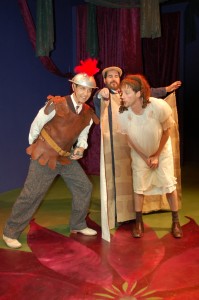 his every bidding). He also plays the mock heroic Pyramus, stunning the audience with his melodramatic performance. Stehlin’s comic antics are largely what give this character such prominence in every scene in which he appears. It’s quite a change from Stehlin as Brutus in Julius Caesar or Titus in Titus Redux.
his every bidding). He also plays the mock heroic Pyramus, stunning the audience with his melodramatic performance. Stehlin’s comic antics are largely what give this character such prominence in every scene in which he appears. It’s quite a change from Stehlin as Brutus in Julius Caesar or Titus in Titus Redux.
Props are minimal on the set of Midsummer. There are no magical forests or dry ice standing in for fog, but Barbara Little’s costumes are incredibly evocative of the play’s transposed setting: 1930s Greece. The Athenians (e.g. Theseus and Hippolyta) sport three-piece suits and don modest calf-length dresses in earthy colors. Lysander is particularly fashionable in his patterned jersey and brown and white wingtip shoes. Such a setting harmonizes well with the Greek names of Shakespeare’s characters. It also allows the fairies to be reinterpreted as gypsies wearing long patchwork skirts and abundant jewelry, and Puck as a Turk in fez and wide-legged pants.
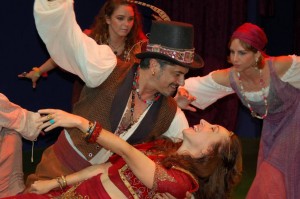 Among the talented cast, the young lovers particularly stand out: Kate Parkin as Helena, Lily Marks as Hermia, Josh Heine as Demetrius and Noah James as Lysander. They get into some splendid arguments and fights, just like siblings do. Parkin’s body language is wonderfully expressive and her denunciation of Marks is particularly passionate. The acting troupe that includes Stehlin’s Bottom is also delightful: Adam Gentzler’s Snug, for example, boasts a bushy red beard and shy eyes that makes him perfect for the role of the bashful lion; as Francis Flute, Brendan Brandt bravely dons female clothing and generously stuffs his bra to fill the appointed role of Thisby, Pyramus’ tragic lover.
Among the talented cast, the young lovers particularly stand out: Kate Parkin as Helena, Lily Marks as Hermia, Josh Heine as Demetrius and Noah James as Lysander. They get into some splendid arguments and fights, just like siblings do. Parkin’s body language is wonderfully expressive and her denunciation of Marks is particularly passionate. The acting troupe that includes Stehlin’s Bottom is also delightful: Adam Gentzler’s Snug, for example, boasts a bushy red beard and shy eyes that makes him perfect for the role of the bashful lion; as Francis Flute, Brendan Brandt bravely dons female clothing and generously stuffs his bra to fill the appointed role of Thisby, Pyramus’ tragic lover.
The New American Theatre, combined with The Odyssey Theatre Ensemble, proves once again its ability to stage classic plays. Midsummer captures the magic and the poetry of Shakespeare’s tightly-crafted drama and instills it with comedy and authenticity. The action never drags and the dialogue never falters, holding the audience rapt from beginning to end.
photos by Jeannine Wisnosky Stehlin
A Midsummer Night’s Dream
New American Theatre at Odyssey Theatre, 2055 S. Sepulveda Blvd.
scheduled to end on June 30, 2013
for tickets, all 310-477-2055 or visit http://www.NewAmericanTheatre.com
